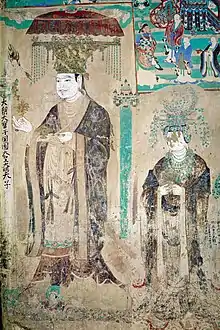Viśa' Saṃbhava
Viśa' Saṃbhava (Khotanese: Viśa' Saṃbhava; in traditional Chinese: 尉遲僧烏波; simplified Chinese: 尉迟僧乌波; pinyin: Yùchí Sēngwūbō; Wade–Giles: Yü-ch῾ih Sêng-wu-p῾o; Chinese name: Li Shengtian, traditional Chinese: 李聖天; simplified Chinese: 李圣天; pinyin: Lǐ Shèngtiān; Wade–Giles: Li Shêng-t῾ien; died 962, 966 or 967) was the king of Khotan from 912 to 962, 966 or 967.[1][2] He adopted Tongqing (同慶, lit. 'celebrating together') as his era name.
| Viśa' Saṃbhava | |
|---|---|
| King of Khotan | |
 Saṃbhava (left) and his queen consort Cao Yijin, Mogao Caves, 10th century. In this mural, him and his queen consort are depicted in Chinese court attires. | |
| Reign | 912–962/966 |
| Successor | Viśa' Śūra |
| Died | 962, 966 or 967 |
| Spouse | Queen consort Cao |
| Religion | Khotanese Buddhism |
He married the second daughter of Cao Yijin, the first governor of the Guiyi Circuit; they had a son named Viśa' Śūra, who would become king of Khotan after his father's death.[2] In another act of marital diplomacy, Cao Yijin's grandson, Cao Yanlu, married Saṃbhava's third daughter.
References
- "Index of Personal Names in: Buddhism in Central Asia I". brill.com. 2020. Retrieved 20 March 2022.
- Mair, Victor; Skjærvø, Prods Oktor (15 December 1991). "CHINESE TURKESTAN ii. In Pre-Islamic Times". Encyclopædia Iranica. New York: Encyclopædia Iranica Foundation, Brill. Retrieved 24 March 2022.
This article is issued from Wikipedia. The text is licensed under Creative Commons - Attribution - Sharealike. Additional terms may apply for the media files.